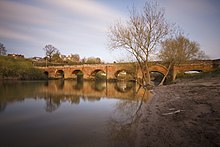Farndon Bridge
| Farndon Bridge | |
|---|---|

Farndon Bridge
|
|
| Coordinates | 53°05′00″N 2°52′47″W / 53.083373°N 2.879820°W |
| Crosses | River Dee |
| Locale |
Farndon, Cheshire, England and Holt, Wales |
| Heritage status | Grade I listed |
| Characteristics | |
| Design | Arch bridge |
| History | |
| Opened | 1339 |
| Statistics | |
| Toll | None (Abolished 1866) |
Farndon Bridge crosses the River Dee and the England-Wales border between the villages of Farndon, Cheshire, England and Holt, Wales (grid reference SJ412544). It is recorded in the National Heritage List for England as a designated Grade I listed building, and is a scheduled monument. In the early 1990s the bridge was restored and renovated and at the same time an archaeological survey was carried out.
The bridge was built in 1339 by Monks from St Werburgh's Abbey Chester. It originally had ten arches with a large gate tower on the fifth arch. In 1770 the tower was demolished and at some time two of the arches on the Welsh side were lost. The bridge is a narrow structure built of red sandstone with eight arches, of which five are over the river. On the Farndon side is one flood arch and two flood arches are on the Holt side.
During the English Civil war, the bridge was the scene of bitter fighting involving up to 4000 soldiers.
Road traffic is single lane and is controlled by traffic lights. There are two narrow footpaths for pedestrians on either side of the road. The bridge was closed for a week in the summer 2014 to allow the Council to undertake a survey of the structure.
The bridge is reputedly haunted by the ghosts of a Welsh prince's two murdered sons, who were drowned in the river.
John Warwick Smith (26 July 1749 – 22 March 1831) a British watercolour landscape painter and illustrator produced a fine painting of the bridge and the landscape around. It has been reproduced since for use on postcards.
Coordinates: 53°05′00″N 2°52′47″W / 53.083373°N 2.879820°W
...
Wikipedia
